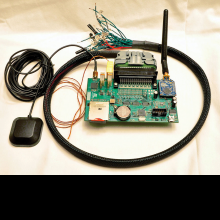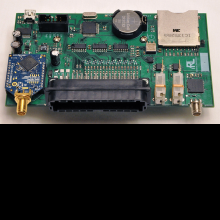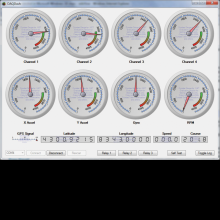DAQPac is an automotive data logger designed from the ground up for motorsports enthusiasts. It has all the features necessary for a driver to improve both their skill and vehicle performance. DAQPac was the result of two prior prototypes, each one evaluating the hardware for function at a reasonable cost. The end result is a well-balanced system, able to provide the features a motorsports enthusiast requires. Powered by a Propeller, the DAQPac interfaces to a powerful set of instrumentation, including:
- (18) 5-volt analog inputs for vehicle sensors
- (2) K-type thermocouple inputs
- (2) inputs for engine spark timing and RPM
- (3) outputs for controlling external relays (i.e. nitrous)
- Onboard X/Y/Z-axis accelerometer and Z-axis angular rate
- High sensitivity GPS with 10Hz update rate
- Secure Digital slot for recording
- Remote Telemetry with onboard long range wireless
- Communication to optional 4.3” touchscreen LCD
Due to the unique architecture of the Propeller, the DAQPac is able to process large amounts of information from several sources, simultaneously. A single cog can be assigned to each task, and the results shared amongst other cogs. For example, a cog is assigned to read the analog inputs at a high rate, another cog to write the data to the secure digital card, and yet another to control relays based on that same data. The counters available to each cog in this design were taken advantage of as well. Specifically, one of the cogs is assigned to poll two thermocouples. While the cog is performing the conversions, both counters are working in the background counting negative edges on different engine tachometer signals.
Robustness of the module was crucial in the design as well. Precision automotive electronics have the difficult task of isolating themselves from a noisy electrical environment. Special care was taken to minimize noise appearing in measurements, and protecting the system from unintentional damage. There is over and under voltage protection available on every analog and digital input, which also protects against transients. Digital outputs are current limited, and auxiliary power connections are protected with user replaceable fuses. The power supply is protected against reverse polarity, and the system can recognize over and under voltages. Finally, during system startup, the accelerometer and gyroscope are put into a self-test mode to verify proper bias and operation.
Mechanically, DAQPac was designed for a sealed, metal enclosure. Both the main connector and antenna connectors have a rubber seal, and the USB and Secure Digital socket can accept a rubber flap. Production boards will also receive a conformal coating to further protect against moisture.




